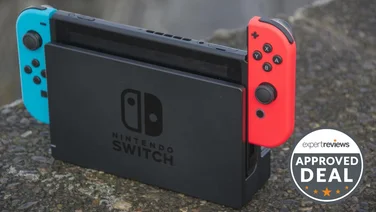To help us provide you with free impartial advice, we may earn a commission if you buy through links on our site. Learn more

Gamers are no stranger to motion tracking: Nintendo put Wii remotes in your hand to play virtual tennis and Microsoft’s Kinect camera can put you in music videos alongside pop stars while you learn the dance steps, but until now the technology was mostly focused on body movement. Steelseries is looking to change that with the Sentry, an eye-tracking system for the PC that can give you (and your Twitch stream followers) an insight into how you play and what you can do to improve.
Eye tracking has other benefits too. Playing certain games on a PC can be a real pain, particularly if they are shoddy console ports with duff controls. The Sentry can employ your own eyeballs as part of your control scheme in supported games.

Steelseries hasn’t developed the eye-tracking tech itself; it comes from Tobii, a company that had previously only created eye trackers for medical equipment and analytical research projects, but it’s hoping the Sentry will be its big break into gaming. It uses three infrared microprojectors to scan the position of your pupils 50 times a second, which can then be used to calculate where you’re looking onscreen. The raw data is smoothed out to appear less jerky onscreen and avoid saccadic movements. You don’t need to actively focus on a particular point either, as the Sentry will follow your eyes wherever they go.
The Sentry attaches to your monitor with a sticky magnetic bracket, letting you pop it on and off whenever you like. You’ll need a USB3 port on your PC to use it, however, as it won’t work over USB2, and it’s only compatible with displays up to 27in, so you can forget about using it on your TV. Once it’s properly aligned on your screen, you just need to perform a quick eye calibration using Tobii’s bundled Eye-X software and you’re ready to play. While most people will want it to track both eyes, you can also choose to track just one pupil if you happen to have a lazy or wandering eye, and it can also account for glasses and contact lenses.
CAMERA CONTROL
Only a few games support the Steelseries Sentry as an input device at the moment, but its primary advocate, Ubisoft’s Assassin’s Creed Rogue, is just one title that shows off its potential. Here, it’s used to control the camera. You can still move the camera with your mouse or a second analogue stick, but controlling it with your eyes is surprisingly natural when you’re running up trees and leaping around the icy reaches of North America.
It’s pretty responsive, too. If you look to the edge of the screen, you’ll turn faster than if you look slightly off-centre, allowing you to quickly turn around if you need to find cover. Surveying your surroundings from the top of a snowy mountain feels incredibly immersive.

However, there’s an inherent flaw in using your eyes to control the camera in this particular title, as it completely diminishes your peripheral vision. This means you can’t really have the camera steady at any one time, as every glance will move the camera to your next point of focus. This is fine if you’re constantly on the move, but it’s during those quieter moments of stealth and reconnaissance that it becomes a real issue.
When you’re sneaking into an enemy base, for instance, you want the camera to help you see round corners in order to clock patrolling guards and obstacles, but this is near impossible when the camera’s jumping back and forth in time with each eye movement. As a result, we constantly felt like we had to wrestle the camera into focusing where we wanted it to go, which was both a hassle and an incredibly unnatural way to play the game.
The same was true of theHunter: Primal, a first-person open-world survival game that throws you onto an alien planet populated with deadly dinosaurs. Controlling the camera felt instinctive while running across the open plains, but the game’s first-person perspective meant it became almost as lethal as a wandering T-Rex when scouting for dinos on the horizon. Because the camera is tied directly to the direction you’re moving, we weren’t able to look around our surroundings naturally while carrying on on a different path. We wouldn’t recommend using it for aiming your weapon either as we found it to be quite imprecise, which is fatal when ammo is so scarce in the first place.
Ironically, indie game Son of Nor addresses this directional problem very elegantly. Here, your eyes act as a cursor, allowing you to pick up, levitate and throw huge rocks at your enemies while facing a different direction. It helps that the game plays out in third person, but it effectively prevents the game from falling into the dreaded tank control scheme that often afflicts so many third and first person games alike (we’re looking at you, Resident Evil).

It certainly lends Son of Nor a more natural and realistic set of inputs, and we only wish theHunter: Primal worked in the same way. Primal does give you the ability to lock the camera in place, allowing you to move your mouse to glance at the horizon without deviating from your chosen route, but this also disables the eye-tracking, as the camera remained stationary when we tried to move it with our eyes.
It’s a shame the Sentry has such a limited selection of games with support for camera control at the moment, as we could see it could be a massive boon for disabled gamers. Specialist eye trackers already exist, but these are typically so expensive to be out of reach of many players, but the Sentry could be a genuinely affordable alternative for anyone that can’t play using a standard controller.
STREAMING & TRAINING
The Sentry’s in-game implementation may not be quite as eye-opening as we first hoped, but it does have another feature that Tobii hopes will appeal to professional gamers as well as anyone who streams games on YouTube or Twitch. In games like StarCraft II and Dota II, for instance, it can add an overlay to your screen that records where you look throughout a match, allowing players and viewers alike to see which parts of the game are most important to you, what you pay the most attention to, and how your play style compares to others. The statistics and graphs help you work out how often you’re looking at important things like the minimap, your resources, and unit counts. We used the Sentry over the course of several weeks as a total Starcraft II novice, and saw a small improvement in our win rate purely through increasing our in-game awareness and watching our replays.


Currently only DOTA 2 and StarCraft 2 are officially supported by the Sentry software, so unless you’re streaming there’s no way to get visual feedback of where you’re looking in other games. Steelseries says more games are due to be added in the future, but there has been no indication as to what titles might make the cut. Because it relies heavily on having access to replays, it may be limited to RTS and MOBA games for the time being, but we’d be intrigued to see it applied to competitive first person shooters like Counter Strike.
The technology has already provided some fascinating insights into how professional players approach games across a whole host of genres. The fascinating video below shows how Japanese Street Fighter player Sako doesn’t actually look at his health or super meters, his character or even his opponent’s character for the majority of a match, but instead focuses on the space between the two fighters.It’s a niche feature, to be sure, limted to a few games and only for serious gamers that want to improve, but for the time being, it’s certainly where we see the Sentry gaining the most traction. Controlling games using eye tracking could be a godsend for players with disabilities, but for the majority it’s little more than a novelty. We’ve yet to see a game that really utilises it in an effective manner that’s free of flaws. We’d love to see it being incorporated into RPG cutscenes, for instance, so characters could tell and react to where we were looking, particularly if we weren’t paying any attention to them while they were midway through a huge speech, but we’ve yet to see any games put these kinds of interactions into effect.
WHERE NEXT?
There may be a glimmer of hope on the horizon, though, as Tobii has made its eye-tracking SDK available to buy for anyone who’d like to try their hand at it. Assassin’s Creed Rogue came to use the technology after the game’s producer saw it being demonstrated at CES earlier this year and bought the development kit almost straight away. Tobii president Oscar Werner even teased the possibility of the upcoming Star Citizen being a potential Sentry candidate when we spoke to him about the future of Tobii’s Eye-X tech, so we’ll be keen to see how developers decide to integrate the device in the future.
Tobii is also confident the technology will eventually be incorporated directly into gaming laptops and PC monitors, with consoles and other operating systems following shortly afterwards. They even have early wearable prototypes that have eye-trackers sitting on top of a pair of glasses which they’re working to make into head-mounted displays.
For now, though, we feel the Steelseries Sentry is little more than an intriguing glimpse into the future, or a seriously niche training tool for streamers and hardcore gamers. This may well change if a new game comes along that absolutely nails the method of implementation, but right now it’s difficult to recommend it for anything other than its streaming features, especially when it’s so expensive. Needless to say, we’ll be keeping a close eye on how it progresses.
| PC requirements | |
|---|---|
| OS Support | Windows 7, Windows 8, Windows 8.1 |
| Recommended CPU | 2.4GHz quad-core Intel i5 or i7 |
| Recommended RAM | 8GB |






